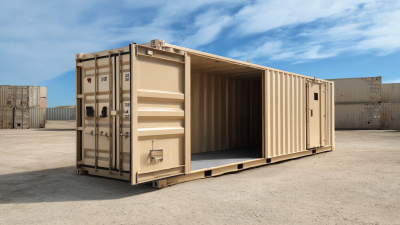Unlocking the Secrets of Cargo Shipping Containers: A Complete Guide to Their Uses and Benefits
In the dynamic world of international trade, cargo shipping containers play a crucial role in facilitating the efficient movement of goods across the globe. According to the International Maritime Organization (IMO), approximately 90% of the world's trade is transported by sea, with over 700 million cargo shipping containers in circulation. These versatile containers not only optimize space and reduce shipping costs, but they also improve safety and security during transport. A report by the United Nations Conference on Trade and Development (UNCTAD) emphasizes that shipping containers have revolutionized logistics, enabling a seamless flow of materials and goods for various industries. As we delve into the secrets of cargo shipping containers, this comprehensive guide will explore their myriad uses, benefits, and the impact they have on global commerce.

Understanding the Versatility of Cargo Shipping Containers in Modern Trade
 Cargo shipping containers have revolutionized modern trade, becoming essential tools for transporting goods across the globe. Their versatility stems from their standardized design, which allows for easy stacking, loading, and unloading. These containers can be used for various types of cargo, from perishable goods in refrigerated units to hazardous materials in specially designed containers, catering to the diverse needs of businesses. This adaptability not only streamlines logistics but also enhances efficiency in supply chains, making global trade more accessible.
Cargo shipping containers have revolutionized modern trade, becoming essential tools for transporting goods across the globe. Their versatility stems from their standardized design, which allows for easy stacking, loading, and unloading. These containers can be used for various types of cargo, from perishable goods in refrigerated units to hazardous materials in specially designed containers, catering to the diverse needs of businesses. This adaptability not only streamlines logistics but also enhances efficiency in supply chains, making global trade more accessible.
Moreover, cargo containers have transcended their original purpose, finding new applications beyond shipping. They have been repurposed into modular buildings, pop-up shops, and even temporary housing in disaster-stricken areas. This trend highlights the sustainability of using shipping containers, as they reduce waste and repurpose existing materials. The multifunctional nature of these containers exemplifies how they support not just trade, but also innovative solutions for various industries, driving economic growth in the process.
Top 5 Benefits of Using Shipping Containers for Storage Solutions
Shipping containers have transformed not only logistics but also personal and commercial storage solutions, offering numerous benefits that cater to diverse needs. According to a recent report by the Containerization International, the global shipping container market is projected to grow at a CAGR of 4.2% through 2027, highlighting the increasing reliance on these versatile units. One of the primary advantages of shipping containers is their durability; made of corrosion-resistant steel, they provide secure storage that can withstand harsh weather conditions, making them ideal for long-term use.
Another key benefit is cost-effectiveness. Research from Statista indicates that renting a shipping container can be 50-60% cheaper than traditional storage options. This is particularly valuable for businesses that require additional space without the financial burden of leasing commercial real estate. Furthermore, shipping containers are incredibly versatile and can be modified for various uses, including workshop spaces, offices, or even homes, catering to the growing trend of container living and modular construction. With these significant benefits, shipping containers offer a practical and economical solution for storage and beyond.
Unlocking the Secrets of Cargo Shipping Containers: A Complete Guide to Their Uses and Benefits
| Benefit | Description | Use Case | Cost Efficiency |
|---|---|---|---|
| Durability | Made from steel, they can withstand harsh weather conditions. | Long-term outdoor storage. | High ROI due to long lifespan. |
| Versatility | Can be used for various purposes including storage, housing, and offices. | Pop-up shops, meeting rooms. | Lower initial setup costs compared to conventional buildings. |
| Mobility | Easily transportable by truck, ship, or train. | On-site construction or events storage. | Saves on logistics costs for relocation. |
| Security | Can be locked and secured to protect contents. | Construction sites, remote locations. | Reduces theft and loss, contributing to insurance savings. |
| Eco-Friendly | Recycling used containers reduces waste and promotes sustainability. | Green building projects. | Saves on material costs and supports green initiatives. |
7 Creative Uses for Cargo Containers in Sustainable Architecture
Cargo shipping containers have transcended their original purpose to become innovative building blocks in sustainable architecture. Their robust structure allows for repurposing into a variety of functional spaces, promoting eco-friendly construction practices. One of the most creative uses for cargo containers is transforming them into affordable housing solutions. By stacking and arranging multiple containers, architects can create efficient living spaces that minimize waste and reduce construction costs.
Additionally, cargo containers are increasingly being used for modular offices and pop-up shops. These versatile units can be easily transported and modified, providing a quick solution for businesses looking to set up temporary or permanent locations. Moreover, the insulating properties of containers can be enhanced with proper materials, making them comfortable environments for work or retail.
Another innovative application is utilizing containers as community spaces, such as schools, galleries, or recreational centers. Their durability and modularity enable communities to build essential facilities in a cost-effective manner while also inspiring creativity in architectural design. Embracing the use of cargo containers not only contributes to sustainable building practices but also fosters a sense of community and innovation.
Essential Tips for Selecting the Right Shipping Container for Your Needs
When it comes to selecting the right shipping container, understanding your specific needs is crucial. First, consider the size and type of cargo you plan to transport. Standard containers come in lengths of 20 or 40 feet, but you might require a high cube or modified container for oversized items. Assessing your dimensions and weight will ensure you choose a container that not only accommodates your goods but also complies with shipping regulations.
Another essential tip is to evaluate the container's condition. New containers offer durability and reliability, but if you're on a budget, used containers can be a cost-effective option. Look for signs of rust, dents, or leaks, and inquire about maintenance history to avoid unpleasant surprises. Additionally, think about the shipping route and climate; opt for containers with insulation properties for temperature-sensitive products, ensuring your cargo arrives in perfect condition. These considerations will help you make an informed decision that aligns with your logistical requirements.

4 Key Factors to Consider When Renting or Buying Shipping Containers
When considering the rental or purchase of shipping containers, there are four key factors that potential buyers or renters should meticulously evaluate. Firstly, the purpose of the container is critical. Different projects require different container types, such as standard containers for storage, refrigerated containers for perishable goods, or modified containers for specialized uses. Understanding the primary function will guide users towards the appropriate specifications and modifications.
Secondly, the condition of the container plays a vital role in making an informed decision. New containers offer better durability and warranty benefits, while used containers can be a cost-effective option, albeit with varying conditions depending on their previous use. Thirdly, the cost and budget must be carefully analyzed. Renting may provide flexibility, while purchasing can be more economical in the long term, depending on usage frequency. Lastly, logistics and delivery should not be overlooked, particularly regarding location accessibility and transportation logistics, which can significantly affect overall costs and convenience. By considering these factors, individuals can ensure they make a well-informed investment in shipping containers.
Benefits of Using Shipping Containers
This bar chart illustrates the key benefits of using shipping containers, highlighting their ratings in terms of cost-effectiveness, durability, versatility, and ease of transportation. Each benefit is rated on a scale from 1 to 10, showcasing why shipping containers are a preferred choice for many businesses and industries.
Related Posts
-

Exploring Innovative Uses for Cargo Shipping Containers in Sustainable Living
-

Maximizing Freshness: Innovative Uses for Refrigerated Containers in the Food Industry
-

Maximize Your Space with 20ft Storage Containers for Efficient Organization and Cost Savings
-

Revolutionizing Food Storage with Shipping Container Freezers for Sustainable Business Solutions
-

Revolutionizing Shipping: The Future of Refrigerated Containers in Cold Chain Logistics
Get a quote
Get a quote
Read More
Accept AllReject AllCustomise
Privacy Overview
| Cookie | Duration | Description |
|---|---|---|
| cookielawinfo-checkbox-advertisement | 1 year | Set by the GDPR Cookie Consent plugin, this cookie records the user consent for the cookies in the "Advertisement" category. |
| cookielawinfo-checkbox-analytics | 11 months | This cookie is set by GDPR Cookie Consent plugin. The cookie is used to store the user consent for the cookies in the category "Analytics". |
| cookielawinfo-checkbox-functional | 11 months | The cookie is set by GDPR cookie consent to record the user consent for the cookies in the category "Functional". |
| cookielawinfo-checkbox-necessary | 11 months | This cookie is set by GDPR Cookie Consent plugin. The cookies is used to store the user consent for the cookies in the category "Necessary". |
| cookielawinfo-checkbox-others | 11 months | This cookie is set by GDPR Cookie Consent plugin. The cookie is used to store the user consent for the cookies in the category "Other. |
| cookielawinfo-checkbox-performance | 11 months | This cookie is set by GDPR Cookie Consent plugin. The cookie is used to store the user consent for the cookies in the category "Performance". |
| CookieLawInfoConsent | 1 year | CookieYes sets this cookie to record the default button state of the corresponding category and the status of CCPA. It works only in coordination with the primary cookie. |
| viewed_cookie_policy | 11 months | The cookie is set by the GDPR Cookie Consent plugin and is used to store whether or not user has consented to the use of cookies. It does not store any personal data. |
| Cookie | Duration | Description |
|---|---|---|
| _cs_c | 1 year 1 month | The cookie is used by Content Square to save the user consent to be tracked. |
| Cookie | Duration | Description |
|---|---|---|
| _cs_id | 1 year 17 days 20 hours 13 minutes | This cookie is used to store the ContentSquare's user identifier ID. This is a persistent cookie and expires after 13 months. |
| _cs_s | 1 hour | This cookie is used to store the number of page's viewed by a visitor within the session for ContentSquare's solution. |
| _ga | 1 year 1 month 4 days | Google Analytics sets this cookie to calculate visitor, session and campaign data and track site usage for the site's analytics report. The cookie stores information anonymously and assigns a randomly generated number to recognise unique visitors. |
| _ga_* | 1 year 1 month 4 days | Google Analytics sets this cookie to store and count page views. |
| _gcl_au | 3 months | Google Tag Manager sets the cookie to experiment advertisement efficiency of websites using their services. |
| Cookie | Duration | Description |
|---|---|---|
| test_cookie | 15 minutes | doubleclick.net sets this cookie to determine if the user's browser supports cookies. |
| Cookie | Duration | Description |
|---|---|---|
| _cs_root-domain | session | Description is currently not available. |
| _cs_same_site | session | Description is currently not available. |